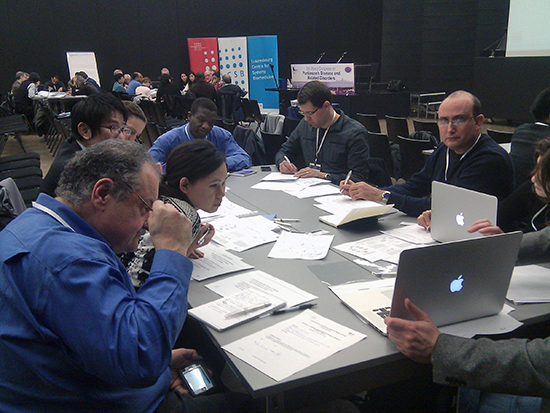Domain expert and community curation#
We would like to encourage the PD community to integrate their expertise, and continuously refine and expand the knowledge available in the PD map.
To support the collaborative curation of PD molecular networks by the research community, the PD map provides features allowing direct and detailed feedback concerning its contents or functionality (see PD map user guide).
Furthermore, direct interaction with the scientific community in hands-on curation workshops facilitate the development of user-oriented functionalities. Special thanks to the Œuvre National de Secours de Grande Duchess Charlotte, Luxembourg, who sponsored our workshops during the last years.
Workshops#
Here we highlight the efforts of the scientific community to support the PD map content curation and the development of new functionalities.
Dedicated curation workshops with domain experts#
PD map curation workshop with Nicolas LeNovèreBelval, Luxembourg, 18 - 19 May 2017#
In May 2017, we were honored to welcome Prof. Nicolas LeNovère (Babraham Institute, Babraham Campus Cambridge) to a PD map curation workshop. In addition, Jennifer Chamarro, Alise Zagare and Marouen Ben Guebila, PhD students at the LSCB, participated.
The first part of the workshop was dedicated to technical discussion on the MINERVA platform, CellDesigner software and compliance with SBGN standards.
major outcome/recommendations:
- simplify data upload and overlay
- enable upload of SBML files to MINERVA
- simplify chemical target search functionalities
- revise selected nodes and edges in the PD map
Thanks to Nicolas and to all other participants for the fruitful discussion and the valuable feedback and suggestions. As always, the outcome of the workshop will feed into our ongoing PD map curation process. Please check the upcoming newsletters to find out how we integrate that into the PD map.
PD map curation workshop with Mark R Cooksonfocused on LRRK2 functions in Parkinson’s diseaseBelval, Luxembourg, 22 April 2016#
In April 2016, we were honored to welcome Prof Mark R Cookson, from NIA, Laboratory of Neurogenetics, Bethesda, MD, USA to a PD map curation workshop. We were also kindly supported by our collaborators from Sanofi, France, Philippe Bertrand and Marlen Weber, and researchers from the LSCB, Sarah Nickels, Jonas Walter, Silvia Bolognin, Lisa Smits, Laura Gonzalez Cano, Anna Monzel, Simone Larsen, Clara Berenguer and Emanuel Berger
We focused on the role LRRK2 and its mutations in the molecular mechanisms of PD. There are a fair number of relevant pathways modulated by LRRK2 and we had a busy day going through them systematically. In detail:
- Microtubules and axonal transport, including LRRK2 interactions with tubulin, Wnt signalling and GSK3B
- Pathways dedicated specifically to LRRK2 activity, emphasizing its interactions with trans-Golgi network, exosomes and formation of inclusion bodies
- Actin filament organization, containing a detailed description of factors governing actin dynamics, including WASH complex and ROCK signalling
- Mitochondrial fusion and fission, including interaction with DNM1L (DRP1)
- Neuroinflammation and microglia signalling
- Regulation of protein translation
- Vesicle dynamics and interactions with a number of RAB proteins
The workshop fed into the PD map update (June’16 release) with 113 new publications and 83 new LRRK2 instances.
PD map curation workshop with the team of Katrin Marcusfocused on the impact of neuromelanin and iron metabolism on Parkinson’s diseaseBelval, Luxembourg, 25 and 26 January 2016#
In January 2016 we had the honour to host Prof Katrin Marcus and her team from the Medizinisches Proteom-Center (MPC), Ruhr Universität Bochum, Germany. Together with the participants from LCSB we had an exciting workshop with focus on neuromelanin and iron metabolism.
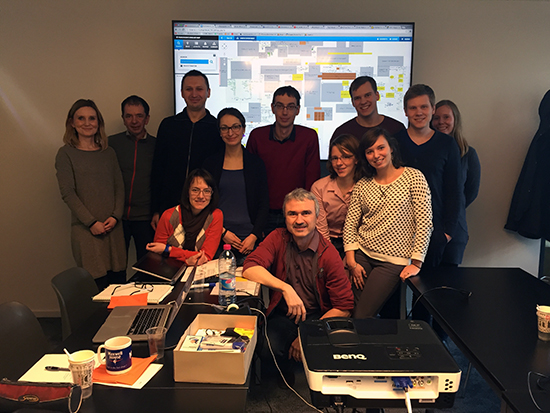
Back row: Caroline May; Michael Kohl; Marek Ostaszewski^; Anastasia Andreas^; Piotr Gawron^; Steffen Kösters; Pascal Rauher; Sarah Plum. Front row: Lorena Cordero Maldonado^; Stephan Gebel^; Simone Steinbach; Zoé Hanss^, Medizinisches Proteom-Center, Ruhr Universität Bochum; (^Luxembourg Centre for Systems Biomedicine, not in the photo: Katrin Marcus)
With the great help of our guests from MPC a list of specific processes and pathways, related to their research domains (i.e., aging of brain in general and age-related neurodegenerative disease such as Parkinson disease and Dementia with Lewy Bodies) were selected for intensive curation.
As neuromelanin is one focus of the research at the MPC a special emphasis was put on the curation of tyrosine/dopamine and ferritin metabolism, lipofuscin and endolysosomal pathways.
To better display iron metabolisms in the PD map, we decided to generate a specific sub map dedicated to iron metabolism with special emphasize on neuromelanin granules and lipofuscin.
The iron sub map was published with the October’16 release of the PD map. Special thanks go to Caroline May and Sarah Plum from MPC for their support.
PD map curation workshop with the team of the team of Tiago Outeirofocused on α-synuclein pathophysiologyBelval, Luxembourg, 27 and 28 July 2015#
In July 2015 we had the honour to host Prof Tiago Outeiro and his team from Department of NeuroDegeneration and Restorative Research, Göttingen, Germany and the NOVA Medical School/Faculdade de Ciências Médicas, Universidade Nova de Lisboa, Lisbon, Portugal. Together with LCSB researchers, we curated the PD map for a day and a half.
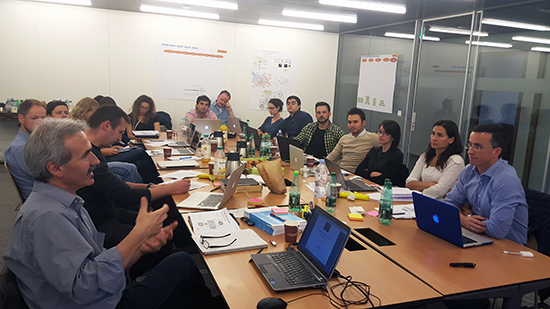
From the left, around the table: Tiago Outeiro1 , Sandra Tenreiro2 , Laetitia Francelle1 , Peter Barbuti3 , Bruno Santos3 , Jonathan Arias3 , Raquel Pinho1 , Manuel Buttini3 , Tomas Fonseca1 , Lisa Smits3 , Maria Pavlou3 , Sarah Nicklas3 , Wiebke Wermheuer3 , Lars Geffers3 , Marek Ostaszewski3 , Stephan Gebel3 . ((1)Center for Nanoscale Microscopy and Molecular Physiology of the Brain, University Medical Center Göttingen. (2)NOVA Medical School/Faculdade de Ciências Médicas, Universidade Nova de Lisboa. (3)Luxembourg Centre for Systems Biomedicine.)
The workshop started with a training on PD map functionalities. The following content curation session focused on α-synuclein pathophysiology. Main suggestions for improvement are listed below.
Posttranslational modifications of α-synuclein:
We discussed how α-synuclein is phosphorylated and acetylated, and how these modifications affect its function. On the basis of the feedback we got, we add new kinases targeting α-synuclein, as well as new phosphorylation residues besides well-studied S129. Another mechanism to add will be α-synuclein acetylation as a protective factor against misfolding.
Functions of WT and mutated α-synuclein:
Thanks to the workshop, new content will appear in the ER-endosomal pathway, where α-synuclein interacts with membrane proteins, re-routes vesicles and gets misfolded. In particular, its interactions with ATP13A2 will be extended. Another area to be improved is the nucleus: we will include mechanisms of α-synuclein nuclear entry and its role in transcription. Finally, we will follow a suggestion to add an oligodendrocyte compartment in the PD map to address reports on synucleinopathies in this type of glial cells.
Results were incorporated into the October’15 release of the PD map.
Internal workshop on oxidative stress and DJ-1LCSB, 3 June 2014#
We have organised a meeting with Lorena Cordeiro, Feng He, Paul Jung, Alexey Kolodkin, Johannes Meiser and Alessandro Michelucci to discuss the representation of oxidative stress and DJ-1 mechanisms in the PD map. We were suggested to improve representation of DJ-1 involvement in one carbon metabolism and NADPH activity, interactions with PSF (SFPQ) and microglia-specific effects.
Internal workshop on dopamine metabolismLCSB, 26 February 2014#
We have organised a meeting with Daniel Weindl, a postdoc in the Metabolomics Group of LCSB, to discuss the representation of dopamine metabolism in the PD map. We have adapted the contents of the map to better represent the picture painted in the recent review on the topic PMID:23683503.
Internal workshop on neuroinflammationLCSB, 12 February 2014#
We have organised a meeting with Manuel Buttini, Djalil Coowar and Alessandro Michelucci from LCSB, to discuss the representation of neuroinflammatory mechanisms in the PD map.
General curation workshops#
PD map meets the Parkinson’s disease communityat the Annual meeting of the GEoPD Consortiumand the International Parkinson’s Disease SymposiumBelval, Luxembourg, 5 – 8 October 2016#
During the four days symposium we hosted two workshops and talked to many guests during the poster sessions. There we present the PD map on a large touch-screen, which allowed us to give live demos of the map.
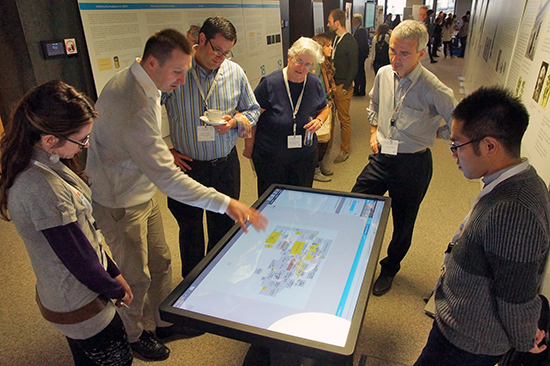
During the first workshop on October, 5th we hosted more than 20 members of the GEoPD Consortium. After a walkthrough of the map content and functions we had inspiring and fruitful discussions with the participants on different topics, including displaying clinical data on the map or engaging the community to participate in the curation of the PD map. We also got important feedback on mapping genetic variants to the contents of the map.
On October, 8th , we held a second workshop with participants of the PD-symposium, including hands-on training on PD map functionalities. After an introductory talk we had three parallel sessions on content curation, experimental data upload and development of new disease maps.
As during previous encounters of the PD map with the community, we got a lot of useful feedback. This time our focus was the user rather than the content. Nevertheless we got valuable comments and suggestions in relation to PD map content which we incorporated in the October’16 release.
Thanks to the great dialog with the members of the GEoPD Consortium and the audience of the PD Symposium.
Systematic Curation of Molecular Pathways implicated in Parkinson’s diseaseMunsbach, Luxembourg, 3 October 2014#
We organised the 2nd edition of this workshop as a satellite event within the 2nd International Parkinson’s Disease Symposium. More than 40 scientists (participants list) from different fields discussed over five hours the newest research findings on molecular pathways relevant in Parkinson’s disease and their representations in the PD map. Thanks to the great commitment of all the participants PD map will be further updated and developed on our blog. Special thanks to the Œuvre National de Secours de Grande Duchess Charlotte, Luxembourg, who sponsored the workshop.
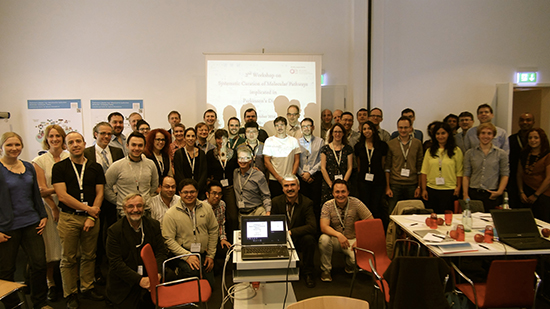
Systematic curation of Parkinson’s disease pathwaysGeneva, 8 December 2013 (participants)#
We have organized a workshop where, in a group of about 50 people we have discussed about pathways implicated in molecular neuropathology of Parkinson’s disease. This was the first event of this type supported by the PD map. We are extremely grateful to all participants (see list above) for supporting us with their expertise.
